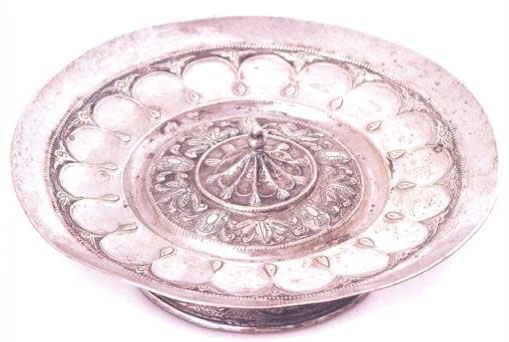24 October
lecture series
PAMPLONA IN CONTEXT
Museum of the San Saturnino workhouse
Ignacio Miguéliz Valcarlos
Museum of the University of Navarra
Throughout history, Spanish churches collected rich collections of silverware, either as a result of donations from the faithful or as a result of direct orders from each parish. However, the continuous wars that took place during the 19th century meant that a large part of these treasures were lost due to their use to defray the costs of the wars. For this reason, the trousseau accumulated by the parish of San Saturnino, including that collected by the chapel of the Virgen del Camino, the patron saint of Pamplona, was considerably reduced and is no longer as rich as it once was.
Despite this, there are many pieces still preserved, largely limited to sacred vessels and pieces necessary for the liturgy, with the works that were unnecessary for worship or merely decorative having disappeared. Since the 1990s, some of these pieces of jewellery have been exhibited as a small museum in one of the outbuildings of the church's workroom. Here, in cupboards and display cabinets, silverware and jewellery, as well as sacred ornaments, are displayed. In this collection, which covers a wide range of periods from the 15th to the 20th century, several pieces of jewellery stand out, such as the reliquary arm of Saint Saturninus, a Gothic work made in 1389 with an architectural base that inscribes enamelled representations of the Saint's history on the windows, on which the arm sits, which is the result of an 18th century alteration.

Also medieval is a large pyx development, with a 14th century dodecagonal prismatic box, with images of the apostles in relief and a conical lid with incised figures of saints, a knotted shaft with 15th century circular kisses inscribed with animals, and a Baroque base decorated with vegetal elements. More advanced, from the 16th century, is the monumental Gothic processional cross, with architectural macolla, on which figures of apostles and saints are arranged. It has flanged arms, with the Crucified Christ presiding on the front, framed by two lateral candles on which the figures of Saint John and the Virgin sit, with the Evangelists at the ends. On the reverse is Saint Saturninus surrounded by the Fathers of the Church.
A curious case is that of one of the four preserved monstrances, carved in Potosí (Bolivia), then belonging to the viceroyalty of Peru, which, although it was bequeathed in 1745 by Pedro Navarro to his cousin, a priest in the parish of Santa María de Olite, was probably taken from this church during one of the seizures of pieces of silverware suffered by the church in the 19th century and bought by Don Melchor de Irisarri, parish priest of San Saturnino, who gave it to the parish church as a gift. Several pieces of civilian type are also preserved, such as a pair of salvillas that reliably copy the design drawn in 1697 by Miguel de Amasa in his examination to obtain the Degree of master silversmith.

The Museum also houses several pieces of jewellery belonging to the trousseau of the Virgen del Camino. This image, the most venerated in Pamplona, received numerous pieces of jewellery throughout its history. However, due to agreement of the work and with knowledge of the donors, the pieces were auctioned as soon as they were received so that the money raised could be used to pay for the construction and decoration of the chapel. As a result, the Virgin barely conserves any important pieces, including two 18th century bibs, one in gold and the other in rhinestones, a brooch in the shape of a 19th century average luna, and a rostrillo made in 1914 by the Pamplona silversmith Esteban García, when Francisco González Viscarret was parish priest. It is a work of gold and diamond and emerald settings, in which Baroque pieces such as ribbons, earring buttons or crosses are set, as well as others from the 19th century. From the same jeweller is a crown for the Child of the Virgin, also carved in gold and set with diamonds and emeralds.

